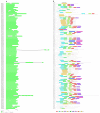Genome-Wide Identification, Molecular Evolution, and Expression Profiling Analysis of Pectin Methylesterase Inhibitor Genes in Brassica campestris ssp. chinensis
- PMID: 29724020
- PMCID: PMC5983585
- DOI: 10.3390/ijms19051338
Genome-Wide Identification, Molecular Evolution, and Expression Profiling Analysis of Pectin Methylesterase Inhibitor Genes in Brassica campestris ssp. chinensis
Abstract
Pectin methylesterase inhibitor genes (PMEIs) are a large multigene family and play crucial roles in cell wall modifications in plant growth and development. Here, a comprehensive analysis of the PMEI gene family in Brassicacampestris, an important leaf vegetable, was performed. We identified 100 BrassicacampestrisPMEI genes (BcPMEIs), among which 96 BcPMEIs were unevenly distributed on 10 chromosomes and nine tandem arrays containing 20 BcPMEIs were found. We also detected 80 pairs of syntenic PMEI orthologs. These findings indicated that whole-genome triplication (WGT) and tandem duplication (TD) were the main mechanisms accounting for the current number of BcPMEIs. In evolution, BcPMEIs were retained preferentially and biasedly, consistent with the gene balance hypothesis and two-step theory, respectively. The molecular evolution analysis of BcPMEIs manifested that they evolved through purifying selection and the divergence time is in accordance with the WGT data of B. campestris. To obtain the functional information of BcPMEIs, the expression patterns in five tissues and the cis-elements distributed in promoter regions were investigated. This work can provide a better understanding of the molecular evolution and biological function of PMEIs in B. campestris.
Keywords: Brassica campestris; PMEIs; evolution; expression patterns.
Conflict of interest statement
The authors declare no conflict of interest.
Figures









References
MeSH terms
Substances
LinkOut - more resources
Full Text Sources
Other Literature Sources

